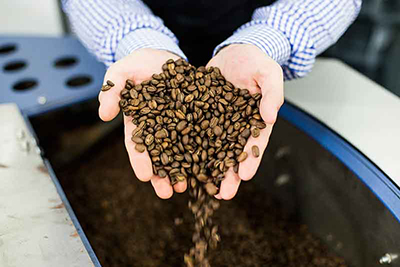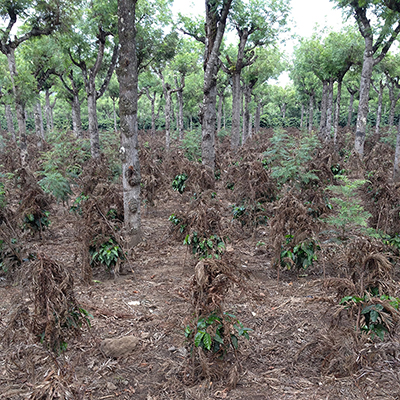What is different from the Arabica Robusta?
Rubiaceae family, which belongs to the coffee tree, has about five thousand items. Of these varieties of coffee trees in fact only about a hundred. The most famous and popular of them -araviyskoe (lat. Coffée arábica), Congolese (Coffee acanephora, otherwise Coffee arobusta), Liberian (Coffealiberica) and ekstselza (Coffee aexcelsa) .Ostalnye varieties do not play a role in the modern economy.
Liberica ekstselza and also did not have much commercial value and are not intended for export. This is for a reason. Coffee Liberica has a strong flavor, but almost does not contain caffeine, and drink from such grains is featureless taste. And, although the plants resistant to diseases, it requires a large amount of moisture in the soil and does not differ yield. Coffee ekstselza can grow, on the contrary, in dry conditions, it is also very resistant to diseases and pests, but is famous for its irregular yields and a very long period of ripening berries. Basically, the grains of these two types of coffee blends used in the confectionery industry and pharmacology, and world production amounts to occupy only 2%.
The remaining 98% is divided between the Arabian and the Congolese kinds of coffee or Arabica and Robusta. Arabica confidently holds the leading position and covers almost 70% of the coffee market, being the most common and cultivated species. And this too has its reasons.
At Arabica - the best quality coffee beans, they contain large amounts of essential oils. The volatile aromatics during frying oil soluble acting on the grain surface. In the preparation of the beverage they are released and form a bright flavor and rich taste. You could even say that it creates all the usual Arabica flavor and aroma of coffee. The content of caffeine in arabica slightly, but there is a pattern: the lower the tree grows above sea level, the greater the percentage of caffeine in the beans.

The name of "Arabica" got this kind because about XIVveke coffee tree seedlings were first removed from his homeland of Ethiopia to the Arabian Peninsula. There has been further spread of coffee throughout the world, until the end of the nineteenth century was the only arabica widely izvestnymego views. In the mountains of Ethiopia are still preserved wild thickets of Arabica.
This is a very whimsical culture. Arabian coffee tree grows best at high altitudes, in this case, the coffee berries have more flesh, they are richer in sugars and other organic compounds. The heat of the tropics at elevations below 900-1200 km and direct sunlight plant tolerates bad, but does not tolerate and lowering the temperature of the air, demanding to moisture and soil quality, susceptible, sensitive to parasites and insects. Fruits ripen slowly Arabian coffee, 8-9 months. For the year, you can collect one or two crops, which is about 3-5 kg of berries and only 1 kg of grain.
Arabica is very difficult to grow. The trees need pruning, fertilizing, close by the sun, protected from pests, warm during the cold snap, and it's all high in the mountains. Harvested by hand, then down to the foot of the mountains. The value and price of arabica develops not only of the quality of coffee beans, but also the complexity of its cultivation.

Robusta more hardy, unpretentious, productivity, tolerates high temperatures, resistant to diseases and pests and grow in the plains, where arabica does not take root. The second species name (synonym) «robusta» translated as "strong, strong." Congolese as this kind of coffee tree is called because the plant was taken out of the Congo. This happened in the early twentieth century, when the disease "leaf rust" were destroyed large areas of plantations of Arabica, and she searched for a replacement. Today, Robusta - an important crop for many tropical countries, occupies about 30% of world coffee production.
However, the Congolese coffee loses part of Arabian taste of the finished beverage. He is sharp, bitter, astringent, with zemlyanistym flavor. Green beans robusta even subjected to special treatment to soften its astringency and bitterness. Also Robusta contains 2-3 times more caffeine than arabica. The cheapness of the coffee is not only connected with the ease of cultivation, but also with the peculiarities of taste characteristics. Mainly used for making Robusta coffee blends and commercial instant coffee, to reduce the cost of the product, are rarely pure. Often Robusta beans, thanks to a dense viscosity, is added during the preparation of espresso for strong foam.
And in arabica and robusta has features that can be used to obtain a certain effect, taste or flavor. Currently displayed a sufficient number of hybrids of Arabica and Robusta (so-called "arabusta") that best preserve the best features of each of the species. For example, the taste characteristics of arabica beans at high resistance to pests and tree diseases like Robusta.
Coffee-class specialty, with which the company operates Traveler's soffee, consists entirely of arabica beans. Only arabica grown in certain conditions, carefully selected, roasted and cooked in a special way, is able to give such an exceptional quality of the finished beverage.
